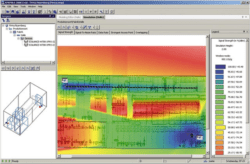Lots has been written in this space about using industrial wireless with PROFINET. This is mostly the ‘what’; this post is to address the ‘how’.
“How do I implement industrial wireless in a PROFINET network?”
Just to recap, while wireless is not just one thing, this will focus exclusively on the most common type of wireless: IEEE 802.11 aka WiFi.
Wireless Site Survey
The first step is to perform a wireless site survey –or have an expert (typically your chosen supplier of Wireless Access Points (WAPs)) do one for you. A wireless site survey maps the location of your WAPs against a blueprint of the factory. The survey displays where one might expect to have a strong signal versus a weak signal. A question we often get in the One Day Training Classes is: “Do I only have to do this once?” The answer is often: “No”. We’ve heard of instances where walls were installed since the initial survey, thus changing the landscape, requiring a re-mapping.
Bandwidth
Most connections via wired Ethernet are 100 Mbit/s. Some Ethernet connections are 1 Gbit/s. Similarly, wireless can have varying data rates from 11 Mbit/s for 802.11b up to 1.3 Gbit/s for 802.11ac. This is important to consider when looking at the number of devices that will connect to a given WAP. Although PROFINET packets themselves are relatively small, there might be other non-PROFINET traffic that shares the bandwidth. Some industrial WAPs have features like bandwidth reservation for automation-related traffic. Check with your supplier.
Speed & Determinism
Any time there is a media transition (e.g. wired-to-wireless or wireless-to-wired), this must be taken into account. We’ve heard of PROFINET installations that are able to achieve update times in the sub-10 millisecond range. So for most applications, wireless should work from a ‘speed’ perspective. But in general, it is non-trivial to check the desired cycle-time against what can be realistically expected.
After that, wireless is transparent in a PROFINET network.
–Michael Bowne

